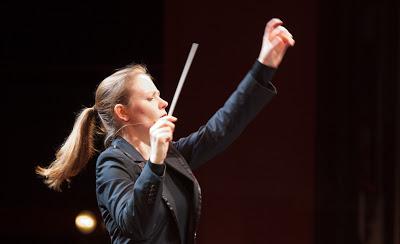by Paul J. Pelkonen

Meet the New boss: Gemma New conducted at NJPAC on Thursday.
Photo by Fred Stucker © 2016 IMG Artists.
Ms. New offered a program of works pitched as celebrations of the national spirit of three very different countries. It began with the overture Aotearoa by her countryman Douglas Lilburn. Lilburn, who wrote this work in 1940 as a tribute to New Zealand, is almost entirely unknown in North America, but performances like this may change that circumstance. Shimmering strings and hushed brass captured the dazzle of sunlight along the beaches of that country's two islands, and a bright thrust of orchestral color sang of the love of this remote and beautiful nation.
Next was the lone Piano Concerto by Edvard Grieg, a work that cemented this Norwegian composer's reputation outside Scandinavia. However, this piece is more firmly rooted in the German tradition in which Grieg was educated. Its sweeping scope, extensive outer movements and pounding, propulsive orchestration recall Brahms, and the flashy solo part could have been written by Franz Liszt. Here it was played by Stewart Goodyear, who brought a fearless approach to the flourishes and ornamentations of the opening movement.
The themes were carefully developed by Ms. New. She used the orchestra to create an elaborate setting for the glittering, jewel-like solo part. Mr. Goodyear shone in the cadenza, playing this music with a total lack of fear and a bold approach to his instrument. The slow Adagio prefaced the Grieg that would come later, with warm woodwind and string writing and a sad, singing central melody. The two-part finale dazzled again, with Ms. New and Mr. Goodyear racing through the finale, a succession of variations on the simple theme of a Norwegian folk dance.
The second half of the program featured Jean Sibelius' Symphony No. 2, written as the Finnish people chafed under the restrictions imposed on them under the Russian Empire. Although Sibelius' music paints portraits of the snows and lake country of Finland, the Second is more of a nationalist and political symphony. In it, the plight of the Finnish people under the yoke of Russia is explored in some detail. A melancholy wind theme alternates with shuddering cellos. From these two ideas, Sibelius builds the first movement.
Ms. New took a brisk approach to the opening movement, but lingered in the slow Andante that followed. She was content to let the woodwinds and plucked basses carry the idea forward in a quest for some form of undetermined justice. The hard-driving scherzo followed, with its bustle of activity in winds and strings interrupted by a trumpet blast, played with force and beauty from the left side of the orchestra. The finale launched itself without pause, and the tentative opening themes suddenly became a triumph.
The key to the finale of this symphony rests with the brass, particularly the horns that have the unenviable task of lifting this whole work to a transcendent state. At Thursday's performance, the NJSO brass were up for the task, producing warmth and a choir of sound that made the listener feel lifted out of their comfortable auditorium chair. The triumph of the Finnish people was also the triumph of Ms. New, who proved herself the equal of anyone else to pick up a baton.

